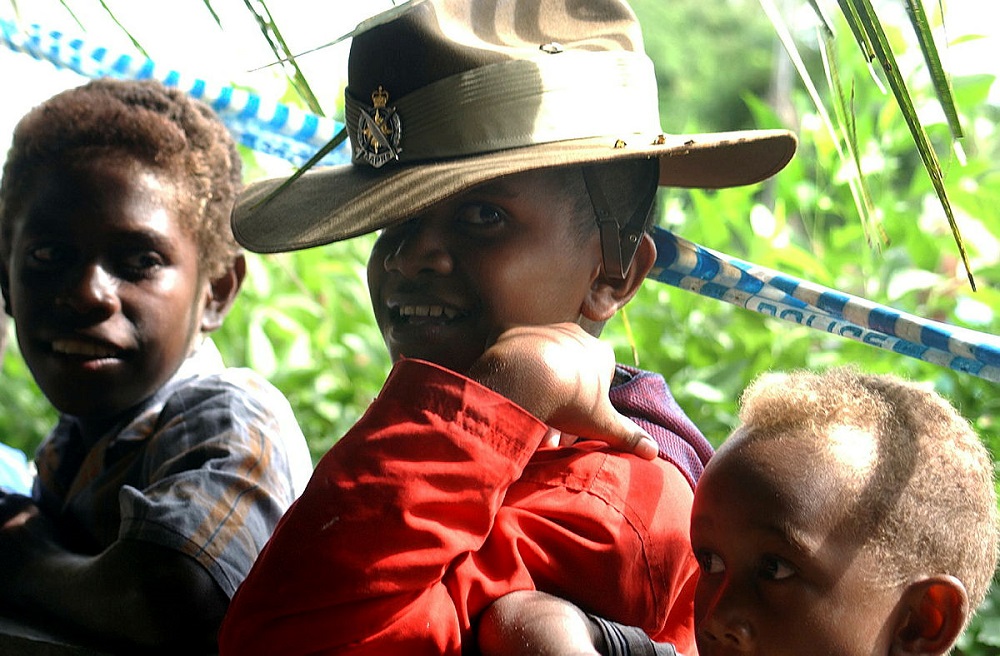
Australia sees itself as the natural leader of the South Pacific. The preferred senior-partner synonyms these days are ‘partner of choice’ and ‘principal security partner’.
Australian leadership ambition has a deep-seated strategic denial instinct, the fear of challenges from rival external powers.
Mirroring the dread of destabilising external players is the ‘trouble in paradise’ worry of internal instability. The South Pacific has strong societies but weak states; the states aren’t getting much stronger while social traditions shift and fade.
The job of regional ‘superpower’ comes laden with loads and laments, and not much reciprocal love.
The islands know they can rely on Australia to turn up and do a lot of lifting. Yet while the South Pacific thinks our heart is in the right place, our head and eyes are often elsewhere. The regional superpower is concerned/distracted by much beyond the region. And always the islands must be wary of Australia’s weight. In Lilliput, the Gulliver dilemma is that the giant can lean in and support, but also lean on and squash.
The story of how all these elements mingle is illustrated by the cabinet records for 2003, released by the National Archives of Australia.
At the start of 2003, the Howard government was marching to war in Iraq and focussed on terrorism. In Asia, the government had what it called ‘the most ambitious and wide-ranging trade policy agenda of any government in Australia’s history’.
As an example of head-and-eyes-elsewhere, there’s little attention or enthusiasm for the South Pacific in the cabinet minute on the release in February 2003 of the government’s second foreign policy white paper, Advancing the National Interest.
Rather oddly, the one Pacific element of the white paper that cabinet ministers highlighted was the kicker final sentence in a paragraph discussing people-to-people links and economic integration with New Zealand: ‘But we remain two sovereign, separate countries, with all that implies.’ (As ever in the kangaroo-kiwi relationship, the kicks are as important as the kisses.)
The white paper emphasised that ‘Australia’s interests are global in scope and not solely defined by geography’. In the South Pacific, the paper grumped, ‘we are prepared to help those countries which are prepared to help themselves’. In the co-ordinating comments that went to cabinet, it was the Defence Department that skewered the grudging tone of the white paper, arguing ‘Australia’s role in the Pacific could be more explicitly recognised to better highlight its importance and relevance to us.’
The truth of Defence’s critique was emphasised later that February in a presentation to cabinet on Australia’s strategic environment by the director-general of the Office of National Assessments, expressing ‘concern about instability in Australia’s immediate region, including the South Pacific states, Papua New Guinea and East Timor’.
The lament about island instability is always a cry about the aches in Australia’s arc of responsibility.
Within months, Australia was performing a policy somersault, scrambling to save a neighbour from that much-feared instability by creating the Regional Assistance Mission to Solomon Islands (RAMSI).
In July 2003, a cabinet minute recorded that the Australian-led military and police contingents would deploy to Solomons from 24 July. The minute reported ‘widespread support’ for the mission in Solomon Islands and contributions being made by ‘other Pacific Island nations, including New Zealand, Fiji, and Tonga’.
As always, Canberra’s offer of leadership needed followship—Australia’s security guarantee has to be accepted and supported.
The operation became Helpem Fren, which is ‘help from friends’ in Tok Pisin. In the planning process, Canberra used the name Solomon Islands Regional Assistance Mission, ‘SIRAM’. Michael Wesley’s book on the mission notes that three days before deployment, Australia’s top diplomat in Honiara, Bob Davis, reported that SIRAM (pronounced sea-rum) was a vulgar term in one of the Solomon’s Malaitan languages. And so, the name switched to become RAMSI. The leader must listen carefully.
Australia showed its willingness to stay the course as RAMSI stretched over 14 years, completing its mission on 30 June 2017. Australia had filled the post of special coordinator throughout and paid most of the cost—the price tag was close to $3 billion.
In June 2003, cabinet extended the life of the ‘Pacific solution’, sending boat people seeking asylum in Australia to South Pacific detention centres. Cabinet accepted a submission on ‘Offshore processing centres: arrangements with Nauru and Papua New Guinea’.
The Pacific solution with Nauru showed Australia as the regional power that could both support and demand, to lean in and to lean on.
When Australia sought to build a detention centre on Nauru, Canberra was in Godfather mode making the bankrupt nation an offer it couldn’t refuse.
Yet as Foreign Minister Alexander Downer later argued privately, Australia would have been pumping money into Nauru even if there’d been no boat people crisis. The regional superpower could not allow an island state to fail. The cabinet submission in June 2003 set out the twin aims of dealing with asylum seekers and support for Nauru’s ‘societal stability’ and ‘improved governance’:
Nauru’s parlous financial situation continues. It remains on the verge of bankruptcy as government revenue is declining and expenditure cannot be met. The population lacks basic services and infrastructure is degraded. Critical infrastructure such as power and telecommunications is being kept from collapse by Australian assistance.
The agreement for the other detention centre on Manus Island, in Papua New Guinea, was a bargain between equals. PNG did Australia a profitable favour. And from long experience, Port Moresby usually extracts a good deal from Canberra.
The Pacific solution was Australia imposing what it wanted on the islands. RAMSI was Australia doing what it must for the islands. In the words of the Ian Hoskins book, Australia & the Pacific, our shared history means ‘Australia has changed its region but the Pacific has changed Australia.’
The desire for strategic denial demands that Australia do leader duty in the South Pacific.

